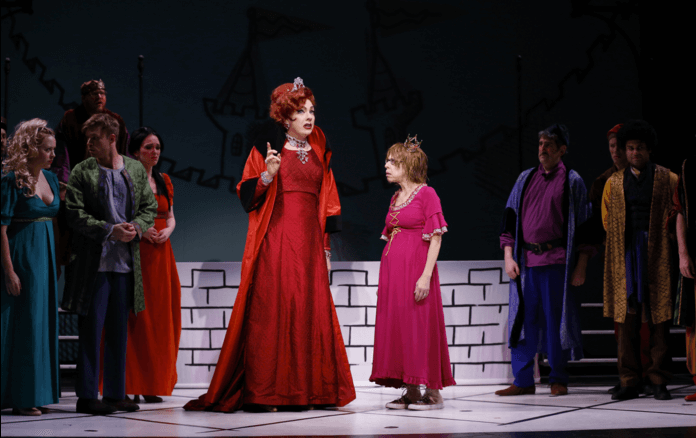Once Upon a Mattress Is a First-Rate Fractured Fairy Tale

Once Upon a Mattress
photo by Carol Rosegg
Once Upon a Mattress
Abron Arts Center
466 Grand Street
A fractured version of the fairy tale The Princess and the Pea, Once Upon a Mattress made a Broadway star of Carol Burnett in 1959, and Burnett re-did it as a TV movie in 2005, this time playing the villainous Queen Aggravain. It features the only really notable musical score written by Mary Rodgers, the daughter of the great composer Richard Rodgers of Rodgers and Hart and Rodgers and Hammerstein fame. Though it doesn’t rise to any of the heights of that Rodgers lineage, Once Upon a Mattress is a good example of how a second-tier musical show from over fifty years ago can look and sound awfully first-rate today.
This is a musical that is old-fashioned in its structure and in some of its attitudes, but Rodgers’s tuneful music and the clever lyrics by Marshall Barer still have vitality and some bite. That bite is at the forefront in this current production of the show from Transport Group because of the inspired casting of downtown curmudgeon Jackie Hoffman as Princess Winnifred, the role originated by Burnett, and John “Lypsinka” Epperson as Queen Aggravain. The highly original performances these two give entirely justify this production, and the comic choices they both make are very strange and mysterious. In between the huge laughs they get, you have to wonder why Hoffman chooses to emphasize a certain word in a line, or why Lypsinka chooses to make a certain crazy frozen face as punctuation for another line.
Hoffman and Lypsinka are doing comic work so delightfully bent and so perfectly finished that they barely notice or need audience response. Hoffman puts over the most famous number in the show, “Shy,” with all the old-time comic oomph of Burnett herself, and seemingly without trying too hard; even when Hoffman howls she seems laidback. She can be more than a little much when she is unconstrained in a role on stage, but here Hoffman hones her vocal and facial ideas down to a bare minimum while Lypsinka goes berserk in a frieze-like but carbonated way that cannot be easily explained. The work Lypsinka does here with just wrists and hands alone could take a whole review to describe; not since the heyday of Maggie Smith has anyone made their wrists so comically expressive on stage. The casting of Lypsinka as the Queen partly solves the problem of the dated “Mom-ism” theme at the center of the book for this musical because Lypsinka always works in such a complex area of female presentation and exposure. The pressure placed on the female character Lypsinka plays is always visible under all of her learned mannerisms, the broad “a” of her speech, and the drive for power that clearly comes from a place of near-total powerlessness.
The other roles are colorfully played by the rest of the cast. Hunter Ryan Herdlicka makes for an attractive and strong-voiced narrator, and though David Greenspan is a bit miscast as the mute king this is almost worth bearing with just to get to the way he explodes with speech, in an old-time vaudeville way, at the very end. Don’t miss the curtain call, where Lypsinka craftily manages to display some leg.
You might also like 



















